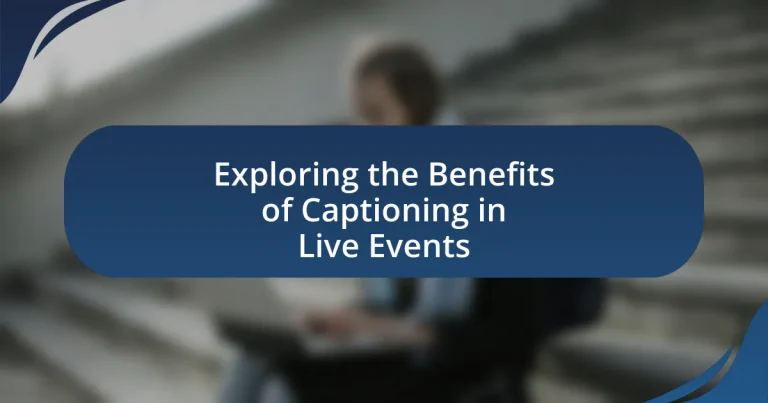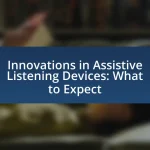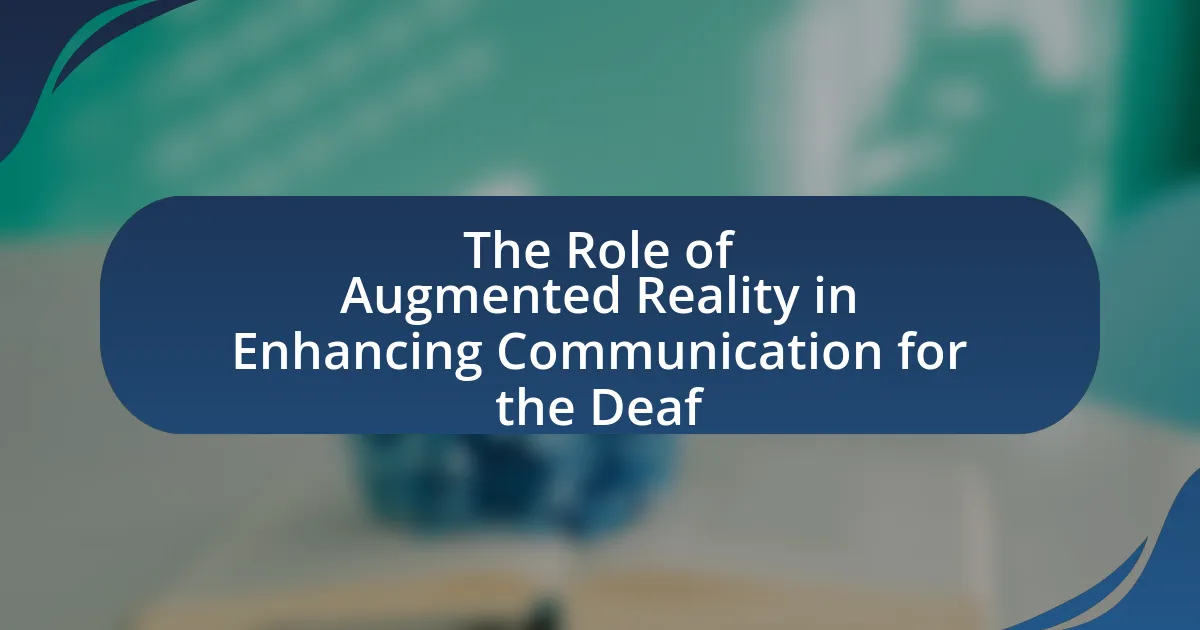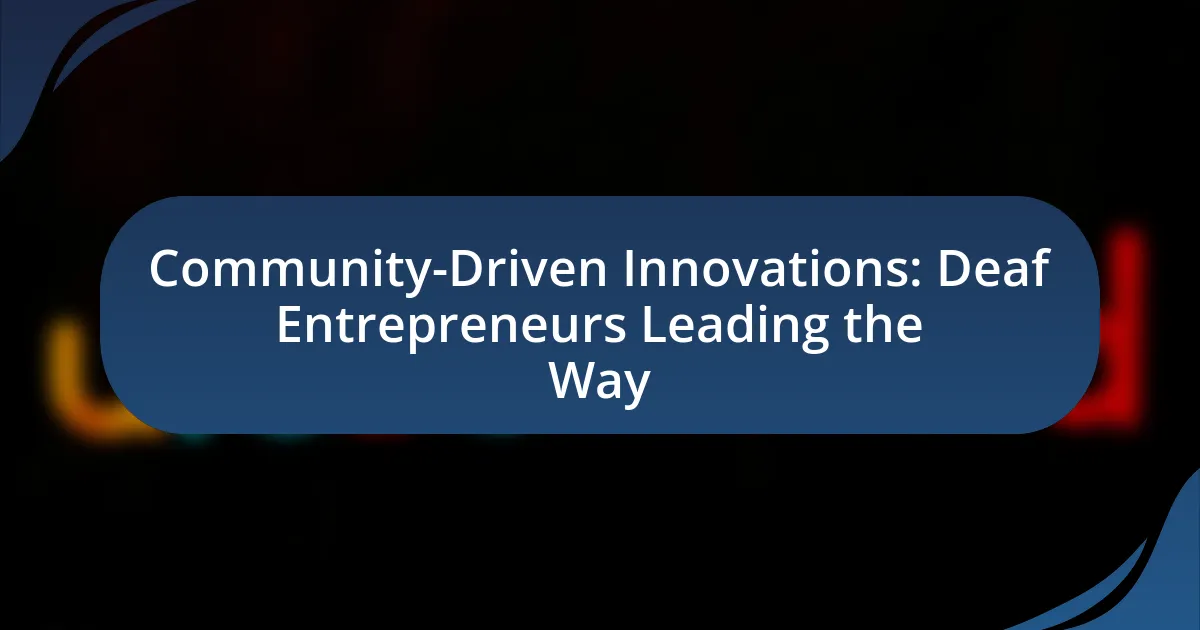Captioning in live events plays a crucial role in enhancing accessibility and engagement for diverse audiences, particularly individuals with hearing impairments and non-native speakers. This article explores the key benefits of captioning, including improved comprehension, audience retention, and overall event experience. It addresses the challenges faced by those with hearing loss, highlights the importance of accurate captioning for effective communication, and discusses best practices for implementation. Additionally, the article examines the impact of captioning on event marketing and audience demographics, emphasizing its significance in creating inclusive environments.
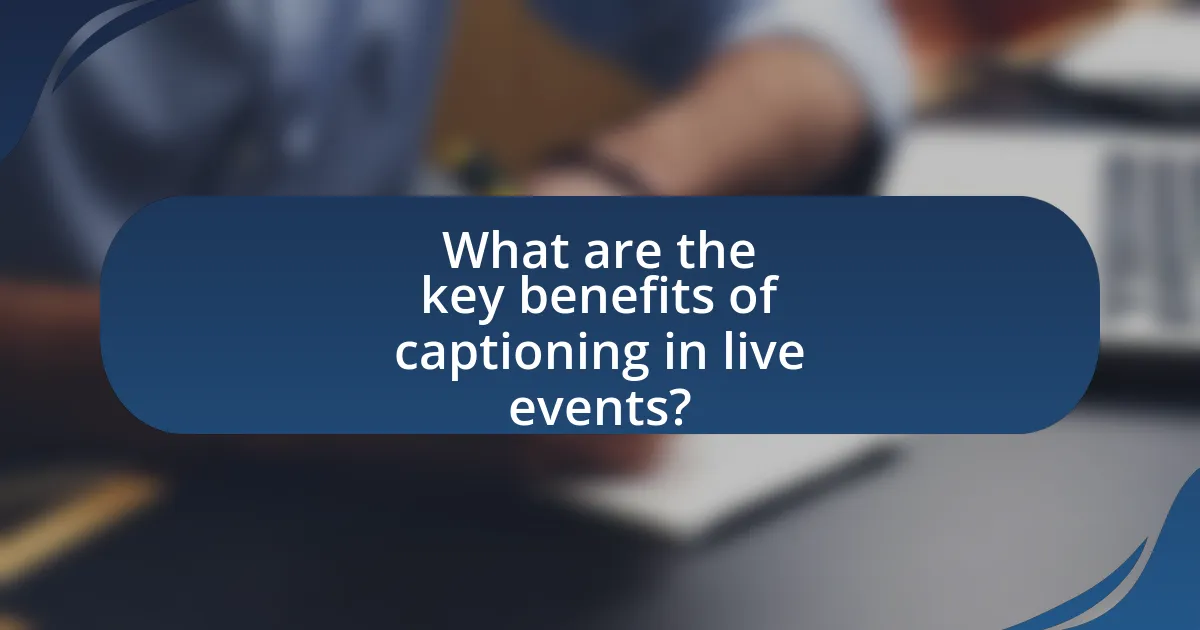
What are the key benefits of captioning in live events?
Captioning in live events enhances accessibility, ensuring that individuals with hearing impairments can fully engage with the content. This inclusion not only complies with legal requirements, such as the Americans with Disabilities Act, but also broadens the audience reach, as studies indicate that approximately 15% of the global population experiences some form of hearing loss. Additionally, captioning improves comprehension for all attendees, as it reinforces spoken content through visual text, which is particularly beneficial in noisy environments or for non-native speakers. Furthermore, captioning can enhance viewer retention and engagement, with research showing that viewers are more likely to remember information presented with captions.
How does captioning enhance accessibility for diverse audiences?
Captioning enhances accessibility for diverse audiences by providing text representation of spoken content, which benefits individuals who are deaf or hard of hearing. This inclusion allows them to engage fully with live events, ensuring they receive the same information as hearing attendees. According to the World Health Organization, over 5% of the world’s population experiences disabling hearing loss, highlighting the necessity of captioning for equitable access. Additionally, captioning aids non-native speakers in understanding dialogue and complex terminology, further broadening audience engagement.
What specific challenges do individuals with hearing impairments face in live events?
Individuals with hearing impairments face significant challenges in live events, primarily due to the lack of accessible audio information. These challenges include difficulty in understanding spoken dialogue, missing out on important auditory cues such as music or sound effects, and the inability to engage fully with the event atmosphere. Research indicates that approximately 15% of American adults report some trouble hearing, which highlights the widespread nature of this issue. Furthermore, without captioning or sign language interpretation, individuals with hearing impairments often experience social isolation and frustration, as they cannot follow conversations or participate in discussions that occur during the event.
How does captioning address these challenges effectively?
Captioning effectively addresses challenges in live events by enhancing accessibility and comprehension for diverse audiences. It provides real-time text representation of spoken content, allowing individuals with hearing impairments to engage fully. Research indicates that approximately 15% of adults in the U.S. experience some form of hearing loss, highlighting the necessity for inclusive communication methods. Additionally, captioning aids non-native speakers in understanding dialogue, as studies show that visual text can improve language acquisition and retention. By ensuring that all attendees can follow along, captioning fosters a more inclusive environment, ultimately enhancing the overall experience of live events.
In what ways does captioning improve audience engagement?
Captioning improves audience engagement by making content accessible to a wider audience, including those who are deaf or hard of hearing. This inclusivity allows more viewers to participate in live events, thereby increasing overall attendance and interaction. Research indicates that 80% of viewers are more likely to watch a video to completion when captions are available, as they help maintain focus and comprehension. Additionally, captioning can enhance understanding in noisy environments or for non-native speakers, further boosting engagement levels.
How does captioning help in retaining audience attention during events?
Captioning helps retain audience attention during events by providing visual text that complements spoken content, enhancing comprehension and engagement. Research indicates that individuals process information more effectively when it is presented in multiple formats; for instance, a study published in the Journal of Educational Psychology found that students who received captions while watching educational videos scored higher on comprehension tests compared to those who did not. This dual-channel processing allows audiences to follow along more easily, reducing cognitive load and maintaining focus on the presentation. Additionally, captioning accommodates diverse audience needs, such as those with hearing impairments or non-native speakers, further ensuring that all participants remain engaged and attentive throughout the event.
What role does captioning play in enhancing comprehension of the content?
Captioning significantly enhances comprehension of content by providing a visual representation of spoken language, which aids in understanding and retention. Research indicates that captioning can improve information recall by up to 80% for viewers, as it allows individuals to read along while listening, reinforcing the message. Additionally, captioning benefits diverse audiences, including those with hearing impairments and non-native speakers, by making content more accessible and easier to follow. This dual-channel processing—auditory and visual—facilitates better cognitive engagement and comprehension of the material presented.
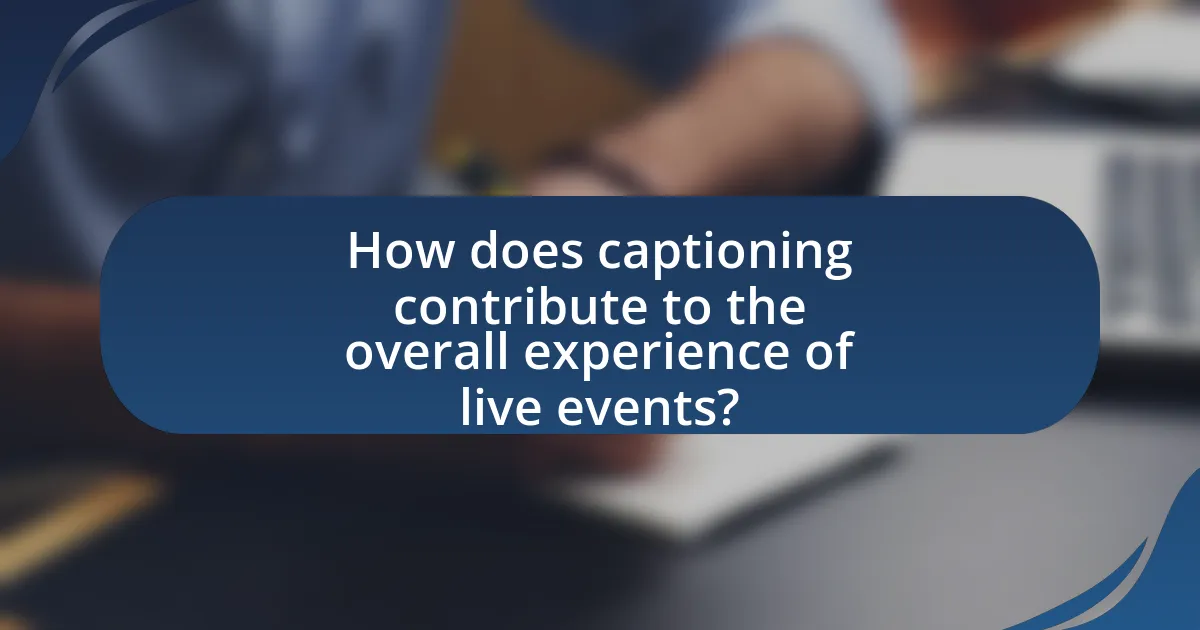
How does captioning contribute to the overall experience of live events?
Captioning enhances the overall experience of live events by making content accessible to a broader audience, including individuals who are deaf or hard of hearing. This inclusivity allows all attendees to engage with the event’s content, ensuring that no one misses critical information or emotional nuances conveyed through dialogue. Research indicates that events with captioning can see increased audience satisfaction and participation, as it fosters a more inclusive environment. For instance, a study by the National Association of the Deaf found that captioning significantly improves comprehension and retention of information during live presentations, thereby enriching the overall experience for all participants.
What impact does captioning have on event production quality?
Captioning significantly enhances event production quality by improving accessibility and audience engagement. By providing real-time text representation of spoken content, captioning ensures that individuals with hearing impairments can fully participate in the event. Research indicates that events with captioning experience increased viewer retention and comprehension, as attendees can follow along more easily. For instance, a study published in the Journal of Accessibility and Design for All found that captioned videos had a 40% higher viewer engagement rate compared to non-captioned ones. This demonstrates that captioning not only broadens the audience reach but also elevates the overall quality of the event experience.
How can captioning reduce misunderstandings during live presentations?
Captioning can reduce misunderstandings during live presentations by providing real-time text that complements spoken language, ensuring clarity for all audience members. This visual representation of speech helps individuals who may have hearing impairments or language processing difficulties to follow along accurately. Research indicates that captioning can enhance comprehension by up to 80% for viewers, as it reinforces auditory information with visual cues, thereby minimizing the risk of misinterpretation. Additionally, studies show that captioning aids non-native speakers in grasping complex terminology and phrases, further reducing potential misunderstandings in diverse audiences.
What are the technical requirements for implementing effective captioning?
Effective captioning requires a reliable audio source, real-time transcription software, and a display system for captions. The audio source must be clear to ensure accurate transcription, while real-time transcription software must support various languages and formats to accommodate diverse audiences. Additionally, the display system should be capable of presenting captions in a readable format, ensuring synchronization with the audio. These technical requirements are essential for delivering accurate and accessible captioning during live events, enhancing audience engagement and comprehension.
Why is captioning important for event marketing and reach?
Captioning is important for event marketing and reach because it enhances accessibility and engagement for a broader audience. By providing captions, events can cater to individuals who are deaf or hard of hearing, as well as non-native speakers who may struggle with spoken language. Research indicates that 80% of viewers are more likely to watch a video to completion when captions are available, which significantly increases viewer retention and participation. Furthermore, search engines index captioned content, improving discoverability and SEO, thereby expanding the event’s reach to potential attendees who may not have been aware of it otherwise.
How does captioning expand the audience demographic for live events?
Captioning expands the audience demographic for live events by making content accessible to individuals who are deaf or hard of hearing, as well as those who speak different languages. This inclusivity allows event organizers to reach a broader audience, increasing attendance and engagement. According to the World Health Organization, over 5% of the world’s population experiences disabling hearing loss, highlighting the significant number of potential attendees who benefit from captioning. Additionally, research from the National Center for Accessible Media indicates that captioning can enhance comprehension for non-native speakers, further diversifying the audience.
What are the potential marketing advantages of offering captioned events?
Offering captioned events provides significant marketing advantages by enhancing accessibility and broadening audience reach. Captioned events cater to individuals with hearing impairments, non-native speakers, and those in noisy environments, thereby increasing attendance and engagement. Research indicates that 15% of the global population experiences some form of hearing loss, highlighting a substantial market segment that benefits from captioning. Additionally, captioned content can improve search engine optimization (SEO) by making event recordings more discoverable through text-based searches, leading to increased visibility and potential audience growth.
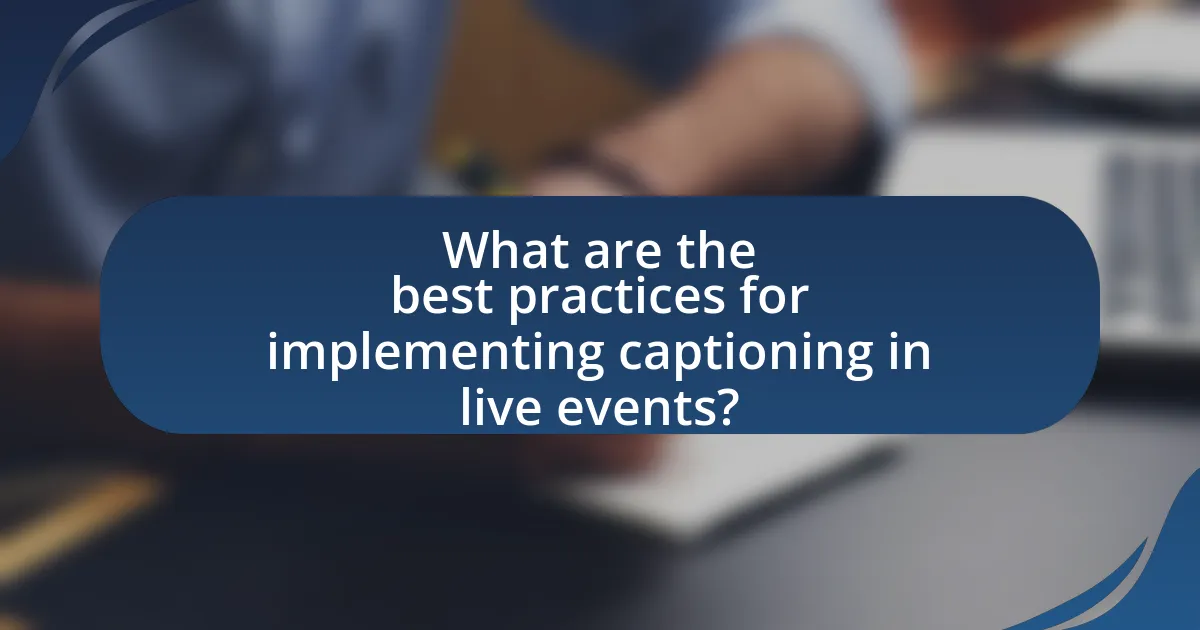
What are the best practices for implementing captioning in live events?
The best practices for implementing captioning in live events include ensuring real-time accuracy, selecting qualified captioners, and utilizing reliable technology. Real-time accuracy is crucial as it enhances audience comprehension and engagement; studies show that accurate captions can improve understanding by up to 80%. Qualified captioners should have experience in the specific subject matter of the event to ensure terminology is correctly represented. Additionally, using reliable technology, such as high-quality captioning software and stable internet connections, minimizes delays and errors, which is essential for maintaining the flow of the event.
How can event organizers choose the right captioning service?
Event organizers can choose the right captioning service by evaluating the service’s accuracy, technology, and experience in live events. Accurate captioning is crucial for accessibility and audience engagement, with studies showing that 80% of viewers are more likely to watch a video with captions. Organizers should also consider the technology used, such as real-time captioning capabilities and integration with streaming platforms. Additionally, selecting a service with proven experience in similar events ensures reliability and quality, as demonstrated by testimonials and case studies from previous clients.
What factors should be considered when selecting a captioning provider?
When selecting a captioning provider, key factors include accuracy, turnaround time, technology used, and customer support. Accuracy is crucial as it ensures that the captions reflect the spoken content correctly, which is essential for comprehension and accessibility. Turnaround time affects how quickly captions can be delivered, particularly for live events where immediacy is vital. The technology employed by the provider, such as automated speech recognition versus human captioning, influences both the quality and cost of the service. Lastly, customer support is important for addressing any issues that may arise during the captioning process, ensuring a smooth experience for event organizers.
How can technology influence the effectiveness of captioning services?
Technology significantly enhances the effectiveness of captioning services by improving accuracy, speed, and accessibility. Advanced speech recognition algorithms, such as those used in automatic captioning systems, can transcribe spoken language in real-time with high precision, reducing errors that often occur in manual captioning. For instance, a study by the National Center for Accessible Media found that automated captioning systems can achieve up to 90% accuracy in ideal conditions, which is crucial for live events where timing is essential. Additionally, machine learning models continuously improve captioning quality by learning from user interactions and feedback, ensuring that captions are contextually relevant and linguistically appropriate. Furthermore, technology facilitates the integration of captions across various platforms, making content more accessible to diverse audiences, including those with hearing impairments.
What common challenges do organizers face when implementing captioning?
Organizers commonly face challenges such as ensuring accuracy, managing costs, and integrating technology when implementing captioning. Accuracy is crucial, as errors in captions can misrepresent spoken content, leading to misunderstandings. A study by the National Center for Accessible Media highlights that 85% of viewers rely on captions for comprehension, emphasizing the need for precise transcription. Cost management is another significant challenge, as high-quality captioning services can be expensive, particularly for live events. Additionally, integrating captioning technology with existing audiovisual systems can be complex, requiring technical expertise and coordination among various stakeholders. These challenges can hinder the effective implementation of captioning in live events.
How can these challenges be effectively addressed?
To effectively address the challenges of captioning in live events, implementing advanced speech recognition technology is essential. This technology can significantly enhance the accuracy and speed of real-time captioning, ensuring that audiences receive timely and precise information. For instance, studies have shown that automated captioning systems can achieve up to 95% accuracy in optimal conditions, which is crucial for maintaining audience engagement and comprehension during live events. Additionally, training captioners with specialized vocabulary related to specific events can further improve the quality of captions, thereby addressing issues related to terminology and context.
What tips can enhance the effectiveness of captioning in live events?
To enhance the effectiveness of captioning in live events, ensure real-time accuracy by using professional captioners trained in the subject matter. Professional captioners can provide contextually relevant and precise captions, which improves comprehension for the audience. Additionally, utilizing high-quality audio equipment minimizes background noise, allowing captioners to capture dialogue more accurately. Research indicates that accurate captioning can increase audience engagement by up to 80%, demonstrating the importance of these practices in live settings.
